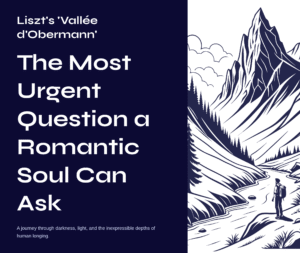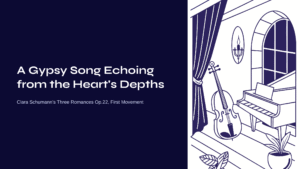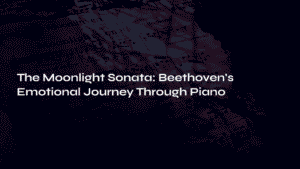Table of Contents

Some Music Opens Doors Through Time
Some music stops time. Or more precisely, time becomes layered, folding upon itself. This moment and a Bohemian village square from over a century ago become one. Every time I listen to Dvořák’s Slavonic Dance No. 8, I experience this strange time travel.
This Presto in G minor begins like someone tapping my shoulder and whispering, “Come now, it’s time to dance!” But this is no gentle waltz. This is a furiant—a passionate Czech couple’s dance. The constant interplay between 3/4 and 2/4 time, creating that peculiar instability, is precisely what makes this music so captivating.

1878: A Composer’s Fateful Encounter
Antonín Dvořák completed his Slavonic Dances, Op. 46, in the summer of 1878. At 37, he was still an internationally unknown Czech composer. This commission from German publisher Fritz Simrock, inspired by Brahms’s Hungarian Dances, would transform Dvořák’s life.
What’s fascinating is that Dvořák didn’t simply quote existing folk tunes. Instead, he recreated the rhythms and emotions he felt in Czech peasant dances through his own melodic invention. Like an adult retelling childhood stories in their own words.
No. 8 is particularly dynamic within this collection. While other dances show lyrical or elegant qualities, No. 8 bursts with relentless energy from beginning to end. The orchestration—from piccolo to double bass, with cymbals and triangle—evokes an entire village celebrating.

The Drama of Dance Unfolding in Music
The Passionate Prelude – Eight Measures That Begin Everything
The opening eight measures are a declaration. The full orchestra’s unified G minor theme seems to shout, “Behold, the real dance begins now!” The cymbal’s striking accents add weight to this proclamation. In this moment, the concert hall’s atmosphere transforms. The audience’s breathing synchronizes.
Strings Lead the Main Theme – An Invitation to Dance
The string theme beginning at measure 9 is this work’s heartbeat. Here Dvořák employs the rhythmic magic peculiar to the furiant. Though notated in 3/4 time, the hemiola effect makes it sound like 2/4, constantly unsettling our sense of pulse.
This rhythmic ambiguity defines the furiant’s identity. This clever device, which confuses even the dancers about which meter they’re moving to, gives the music unpredictable vitality.
The Turn to G Major – A Moment of Hope
When the main melody shifts to G major, it’s like sunlight breaking through clouds. The woodwinds warmly embrace this melody, which feels both melancholic and hopeful. But this tranquility doesn’t last—we soon return to minor key passion.
The Development’s Whirlwind – Emotional Climax
The development section beginning at measure 49 is the true climax. The main themes fragment and sequence through shifting keys, with the music growing increasingly intense. Here Dvořák explores every orchestral possibility. Winds echo each other, strings pour out virtuosic passages, and percussion maximizes rhythmic drive.
The Coda’s Frenzy – Dance’s Grand Finale
The final coda rushes at an even faster tempo than Presto. Every instrument becomes part of one massive whirlwind racing toward G minor’s perfect cadence. The ecstasy of this moment is truly breathtaking.

What I’ve Discovered in This Music
Each listening reveals something new. Initially just an exciting dance piece, repeated hearings reveal complex emotions hidden within. The structure alternating between G minor’s dark passion and G major’s bright hope seems like a condensation of life’s joys and sorrows.
The instability created by hemiola rhythms isn’t merely a technical effect—it’s Dvořák’s unique way of expressing life’s uncertainty. This feeling of being one beat off from our expectations resembles the bewilderment we feel when life throws us unexpected curves.
Above all, this music contains communal warmth. Sounds impossible for one person to make, harmonies created by multiple instruments working together—these directly convey the joy of villagers dancing together.

Three Points for Deeper Listening
First, Focus on Rhythmic Magic
Consciously follow the hemiola effects where 3/4 and 2/4 time intersect. Though initially challenging, once you’re accustomed to this rhythmic illusion, you’ll feel the furiant’s true excitement. Don’t miss those moments when strings and winds maintain different pulse sensations while creating unified music.
Second, Savor Orchestrational Colors
Dvořák uses every orchestral color in this work. The shimmer of cymbals, triangle’s subtle resonance, woodwinds’ warm conversations, brass’s majestic declarations. Listen consciously to when each instrumental group appears and what role it plays—the music becomes far more three-dimensional.
Third, Trust in Repeated Listening
This piece can’t be fully grasped in one hearing. Each repetition reveals new melodies and rhythmic details. How themes are varied in the development, how all elements synthesize in the coda—these only become visible through multiple listenings.

What the Music Leaves Behind
After hearing Dvořák’s Slavonic Dance No. 8, I’m left with a strange feeling. Like returning from some festival with both the satisfaction of participation and the melancholy that it’s over. This is the magic this music possesses.
A four-minute dance piece created by one Czech composer over 140 years ago still makes us dance today. At the intersection where music’s power to transcend time and space meets the universal human emotions of joy and sorrow, this work will live forever.
Next time you hear this piece, close your eyes and imagine: the dance of peasants in some 1878 Bohemian village square, and the life’s joys and sorrows contained in that dance. You’ll discover yourself dancing with them across time.

Next Destination: Into the Fairy Forest
If you’ve been intoxicated by Dvořák’s rough earthbound dance, why not journey to a completely different world? Mendelssohn’s Scherzo from *A Midsummer Night’s Dream* awaits as our next destination. From Czech peasants’ passionate steps to the mysterious forest where Shakespeare’s fairies dance.
If Dvořák’s No. 8 is a powerful dance that pounds the earth, Mendelssohn’s Scherzo is a fantastical dance that seems to float in air. This scherzo, which proved again at 33 the genius he’d shown in his overture at 17, is filled with playful dialogue between woodwinds and strings. Especially the final section where flute dances as lightly as fairy wings completely transports us from Czech soil to Shakespeare’s fantastical realm.
Both works share the common denominator of “dance,” but one sings of human reality while the other celebrates imagined magic. Isn’t this contrast precisely the delight of classical music’s infinite spectrum?



